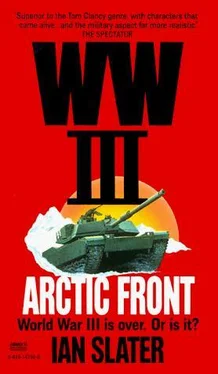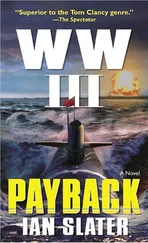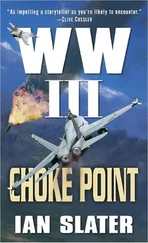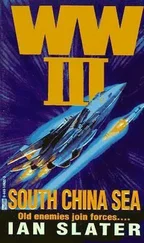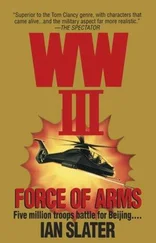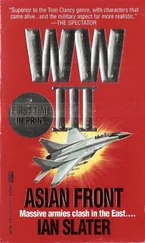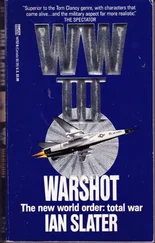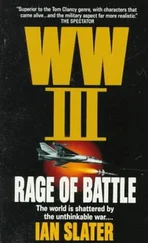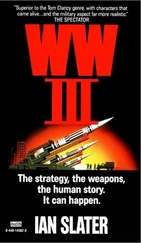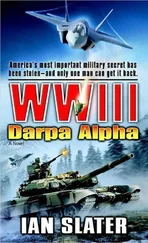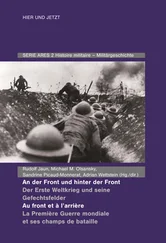“All right, relax, Dick. Won’t say anything to offend the—” He paused, “—lady. I suppose if I call them ‘lathes’ I’ll be on a discrimination charge.”
“Will I put a call through, General?”
“Later — when we go below. But Dick?”
“Sir?”
They were passing through the “light lock,” in whose chamber all illumination went out as soon as they began to spin the wheel to open the outer door leading to the deck. Although Norton could not see the general, the latter’s tone had changed to one of dead seriousness. “Aren’t any females in the tank divisions, are there? I told the Pentagon about that. I don’t want any tank crewmen killed trying to figure out how some dame is going to piss in her helmet while everybody looks the other way. Last I heard Siberia’s armored don’t give the enemy time off for rest stops and I—”
“No women in the armored units, General, far as I know. Support, perhaps, but not in the tanks themselves.”
Norton had lied. It had been an ongoing fight between Freeman and the Pentagon since the beginning of the war. There were several women, Norton knew, qualified as gunners, but he wasn’t having the commander of Operation Arctic Front suffer a coronary before any of the first three landings they were going to make on the Kuril Islands, the opening stage of the air-land battle. Freeman was silent for a few minutes as they stood on the flight deck, cold Arctic air whistling about them, the salty tang at once invigorating and freezing, stars showing through intermittent clouds but the sky on their westward heading thickening. The sea was moderate so far, but the latest meteorological report showed the state of sea deteriorating the further westward the task force steamed.
“First few hours’ll be critical, Dick. As it always is, of course, in an operation of this kind, but particularly here. We need the Kurils for air bases as well as those in Japan if we’re going to make the landing on eastern Siberia proper.”
Two of the three landings, unknown to anyone but battalion-level commanders, were feints, “Persian Gulfs,” so-called because of the Marine feint made off the beaches of Kuwait during the Iraqi war while the Twenty-fourth made their end run around the Republican Guards. Only in this case the marine feints would be to sucker Siberian navy and air-arm elements away from the main landing. Meanwhile Freeman, as supreme commander, had designated the Petropavlovsk sub base on Kamchatka a top-priority air target, the attacks on the sub pens to be launched from Attu Island at the western end of America’s Aleutian chain, which curved like a scythe toward Kamchatka, Siberia’s sparsely populated protective arm.
* * *
Steaming out from Vladivostok, with Admiral Baku in command, was the center of the Soviet interdiction force, the sleek, 910-foot-long, 110-foot-wide, 43,000-ton “Kiev” class carrier Murmansk, her deck sprouting vertical/short takeoff Forger A and B fighter bombers together with Ka-25 Hormone and Ka-27 Helix antisubmarine helicopters. The carrier’s four shafts spun effortlessly through the northwestern Pacific under the impetus of the ship’s 210,000 horsepower. At thirty knots the carrier’s speed eastward to meet the American force was aided by prevailing westerlies and the eastward-flowing Kuroshio Current. Murmansk was seven knots slower than her opposite number, the 1,040-foot-long, Nimitz class carrier USS Acheson, under the command of Adm. Charles Burke. Her flight deck 252 feet, her displacement 91,487 tons, she was twice as big as the Murmansk, her two nuclear reactors giving her the 280,000-shaft horsepower with which to move her ninety-four aircraft westward. The aircraft were a “medley,” as Burke referred to them, of F-14 Tomcats, F-15 Strike Eagles, F-4G Wild Weasels, Grumman Intruders, and a pride of two Stealth fighter bombers.
At first glance the core of Baku’s twenty-four-ship Siberian force around the Murmansk— her screen including two guided-missile cruisers, fifteen missile destroyers, and six fast frigates — seemed to be outclassed by the thirty-one-ship American battle group concentrated about the USS Acheson, with its screen of five 9,600-ton Ticonderoga class guided-missile cruisers, five 11,000-ton Virginia class cruisers, and twenty Truxtun and Bainbridge class destroyers. And the Siberians were outclassed — on the surface. This despite the fact that the Murmansk carried something deadly in addition to aircraft — namely four twin surface-to-air launchers, twelve vertical surface-to-air N-9 launchers, and eight surface-to-surface, that is, ship-to-ship N-12—Sandbox, 340-mile-range — missiles with eight reloads.
In addition to the Baku task force, however, the Siberian commander had ordered two nuclear-powered, 24,000-ton Kirov class battle cruisers out of Pacific Fleet headquarters at Petropavlovsk. Speeding eastward at thirty-two knots, the rang korablyna— “first-class rated”—Kirov cruisers carried fifty-two missile launchers each and ten antisubmarine torpedo launch tubes. They sliced through the swells on their way to intercept the Wisconsin and Missouri, which were en route to shell the Kommandorsky Islands air base off Kamchatka, from which Freeman did not want to be harassed on his northern flank. The mission of the two Siberian cruisers was to dispose of the old American battle wagons, thus saving the Kommandorskys — after which the two Siberian cruisers would proceed further south to harass the American task force’s northern flank. And the American advantage in number of ships over the Siberians was about to be drastically redressed by Baku’s use of a piece of equipment that the Soviet admirals, true to the Leninist dictum of quantity producing its own quality, believed would overwhelm more sophisticated weaponry.
Baku, with the formidable backing of his admirals in the Red Banner Pacific Fleet in Vladivostok, had got what he wanted: flotillas of over three hundred relatively cheap, high-powered, highly efficient “littoral” craft small missile patrol and torpedo boats for regional defense. These consisted of the Sarancha class (148-foot, 60-knot attack hydrofoils carrying 60-mile-range SS-N-9 and SS-N-4 missiles with a multibarrel, thirty-millimeter gun for close-in work), the hydrofoil Matka class boats (armed with two Styx antiship missiles, a 76.2-millimeter forward gun, and a multibarrel thirty-millimeter), and Nanuchka class Ills. The latter was in effect a thirty-thousand-horsepower-driven guided missile Corvette, which, though only 194 feet, 6 inches long, and with a draft of less than eight feet, carried SS-N-9 Siren antiship missiles in two triple launchers and also a surface-to-air N-4 antiaircraft missile. It was the same class of ship that, sprouting a 76.2-millimeter antiaircraft gun and thirty-millimeter close-in multibarrel, had been the spark that lit the fuse of war when it had attacked Ray Brentwood’s USS Blaine off Korea.
The advantage the gidro-samofyot— “skimmer craft”—had, running with or without foil, was that not only did their high mobility mitigate against being bit, but because of their small size, they could weave through the wave clutter that blocked American radar. And their very presence as they attacked the Americans would cause the slower U.S. warships to expend much of their fuel and oblige the U.S. carrier to use up vital fuel in launching sorties to deal with the small, fast attack boats. Thus they would siphon off the U.S. battle group’s main aerial cover, including those planes that would otherwise have been designated “strikers” as a prelude to Freeman’s amphibious landings. One missile from any of these swarms of small, fast boats would be devastating against any of the modern-hulled American ships.
Читать дальше
